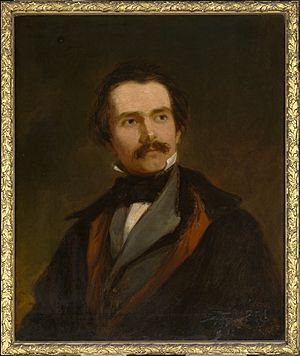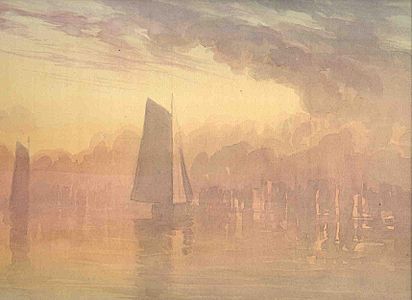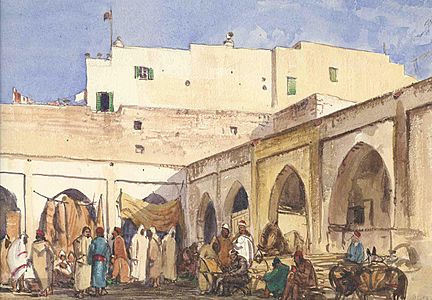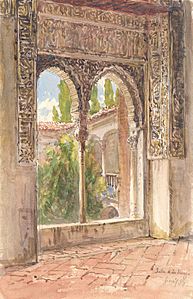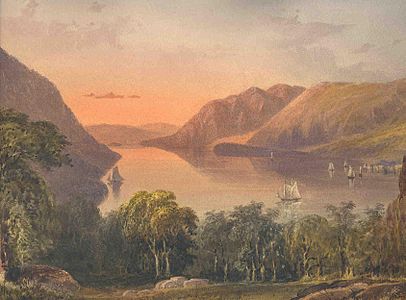Truman Seymour facts for kids
Quick facts for kids
Truman Seymour
|
|
|---|---|
 |
|
| Born | September 24, 1824 Burlington, Vermont |
| Died | October 30, 1891 (aged 67) Florence, Italy |
| Place of burial |
Cimitero Evangelico degli Allori, Florence, Italy
|
| Allegiance | United States of America Union |
| Service/ |
United States Army Union Army |
| Years of service | 1846–1876 |
| Rank | |
| Commands held | 5th U.S. Artillery |
| Battles/wars | Mexican–American War |
| Other work | Painter |
Truman Seymour (September 24, 1824 – October 30, 1891) was a soldier and a talented painter. He fought for the Union Army during the American Civil War. He rose to the rank of major general. He was at the start of the war at Battle of Fort Sumter. He also led Union troops in the Battle of Olustee, which was the only major Civil War battle in Florida.
Contents
Becoming a Soldier and Artist
Seymour was born in Burlington, Vermont. His father was a Methodist minister. In 1840, Truman started attending Norwich University. After two years, he joined the United States Military Academy (West Point). He graduated in 1846, ranking 19th out of 59 students. His class was famous, with many future generals like George McClellan and Thomas J. "Stonewall" Jackson.
Right after graduating, Seymour served in the Mexican–American War. He was recognized for his bravery in the battles of Contreras and Churubusco. He was given the honorary rank of captain. Six days later, he was promoted to first lieutenant. After the war, he taught drawing at West Point from 1850 to 1853. He also fought against the Seminoles in Florida from 1856 to 1858. He became a captain on November 22, 1860.
Truman Seymour in the Civil War
Before the Civil War began in 1861, Seymour helped prepare Fort Moultrie for battle. When the war started, he commanded an artillery company. They defended Fort Sumter against the Confederate attack. For his actions, he received the honorary rank of major.
From December 1861 to March 1862, Major Seymour commanded the 5th Regiment of Artillery. He also led the U.S. Camp of Instruction in Harrisburg, Pennsylvania. He became the Chief of Artillery for General George A. McCall's division. On April 5, 1862, President Abraham Lincoln nominated Seymour to become a brigadier general. The United States Senate approved this on April 28, 1862.
Fighting in the Peninsula Campaign
General Seymour served in the Army of the Potomac during the Peninsula Campaign in 1862. He led troops in several important battles. These included Mechanicsville, Gaines' Mill, and Glendale. At Malvern Hill, he took command of the division after General McCall was captured.
After this campaign, Seymour's troops joined the Army of Virginia. He performed well in battles like Second Bull Run, South Mountain, and Antietam in late 1862. He was especially noted for capturing Frosttown Gap in Maryland. He received honorary promotions to lieutenant colonel and then colonel for his bravery.
Challenges in South Carolina
In November 1862, General Seymour moved to the Department of the South. He became chief of staff there. He led a division on Folly Island, South Carolina, in July 1863. He also took part in the attack on Morris Island. Later, he commanded a difficult attack on Fort Wagner on July 18. This attack was controversial. He placed the famous 54th Massachusetts Volunteer Infantry at the front. This was a Black regiment, known from the movie "Glory". Seymour was badly wounded by grapeshot during this attack. He saw little field duty for the rest of 1863.
The Battle of Olustee
Major General Quincy A. Gillmore put Seymour in charge of the new District of Florida. In February 1864, Seymour's division went to Florida. They landed and took control of Jacksonville. Gillmore then returned to South Carolina, leaving Seymour in charge of the troops.
On February 20, Seymour's force of about 5,500 men met a Confederate force of about 5,000. The Confederate troops were led by Brigadier General Joseph Finegan. The battle happened near Olustee, about 40 miles west of Jacksonville. This battle had some of the highest losses, by percentage, of any major battle in the war. Seymour's division caused nearly 1,000 casualties for the Confederates. However, his own force suffered almost 2,000 casualties. General Seymour's defeated force returned to Jacksonville. Union troops kept control of Jacksonville until the war ended.
Final Battles of the War
After Olustee, General Seymour remained in command of the District of Florida until March 28, 1864. He then returned to Virginia. He led a brigade in the Battle of the Wilderness in May. During this battle, he was captured by Confederate General John B. Gordon. He was exchanged on August 9. Seymour then took command of the Third Division of VI Corps. He fought in the final battles of the Shenandoah Valley. He also participated in the Petersburg campaign, the Sayler's Creek, and the Appomattox Campaign. He was present when General Robert E. Lee surrendered on April 9, 1865.
In 1866, President Andrew Johnson nominated Seymour for the honorary rank of major general. He also nominated him for brevet brigadier general in the United States Army. Both nominations were confirmed by the United States Senate.
Life After the War
Seymour left the volunteer army on August 24, 1865. However, he stayed in the Regular United States Army. He served again in the 5th Artillery. He later commanded forts in Florida, Fort Warren, Massachusetts (1869–70), and Fort Preble, Maine (1870–75). He retired from the army on November 1, 1876.
In 1865, he received a master's degree from Williams College. Seymour spent his retirement years in Europe. He died in Florence, Italy, and was buried there.
Seymour was also a watercolor painter. He painted many pictures while living in Europe during his retirement. He is believed to have never sold his paintings. However, his artwork can be found in museums and private collections today.
Gallery
See also
- List of American Civil War generals (Union)
- John C. Waugh, The Class of 1846, Ballantine Books, New York, 1994.
- Water Color and Drawings by Brevet Maj. Gen. Truman Seymour, Exhibition Catalog, United States Military Academy, Kent Ahrens, 1974.
- The Drawings and Watercolors by Truman Seymour, organized by the Everhart Museum, Scranton, 1986.


